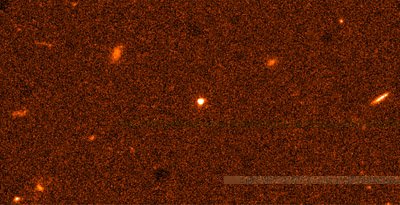
June 10, 1997
Photo No.: STScI-PRC97-22
The visible fireball from a titanic explosion in deep space, called a gamma-ray burst, blazes in the center of this image, taken with the CCD camera (Charge Coupled Device) on the Space Telescope Imaging Spectrograph, a new instrument on Hubble Space Telescope.
The burst occurred on May 8, and Hubble observations to acquire the fading fireball were made on June 2. No accompanying object, such as a host galaxy, can be found near the burst. This result adds to the puzzlement over of the source of these enigmatic explosions, because a previous Hubble image of another gamma-ray burst counterpart identified a potential host galaxy. If a galaxy is present, and at the distance suggested by Keck spectroscopy, it is much fainter than our Milky Way. A few faint galaxies are, however, seen several arcseconds from the source. If one of these is the host, then the gamma-ray burst is very far out in the galaxy's halo, well outside the galaxy's stellar disk.
Credits: Elena Pian (ITESRC), Andrew Fruchter (STScI), and NASA